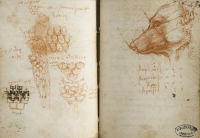Rule of Mathematics Click on the thumbnails to explore the trail
Read more about this trail (expand)
Leonardo believed that all things in nature were governed by mathematics. Mathematics was of supreme importance and expressed incontrovertible, universal truth. Knowledge of mathematics was a prerequisite for understanding the nature of all things. “Let no-one who is not a mathematician read my principles”, Leonardo said. Geometry and its actual or potential relationship to natural forms provided a suitably visual means for the exploration of mathematical “truths”.

- Enlarge
- Zoom & explore
- Fol 47v-48r - Study of the proportions of a dog's head. Photo RMN © René-Gabriel Ojéda
Paris Manuscript I 1497-1505
Contact with the mathematician Luca Pacioli in Milan had a profound effect on Leonardo. His subsequent studies of proportions in nature indicate an increasingly scientific approach.
In the highly finished study of a dog’s head on the right sheet, Leonardo has exploited the expressive potential of red chalk to model the head in light and shade, using the white of the paper to define the highlights. The linear technique beautifully conveys the wiry texture of the dog’s coat and the complex shadows of its muzzle.
Once the profile had been captured, Leonardo proceeded to establish the proportions of the animal’s head. One can imagine his delight in discovering that the distance from the tip of the dog’s snout to its brow is exactly equal to the distance from its brow to its ear, and that the lowest point of snout is on a line with the lowest point of the ear.
On the opposite page, Leonardo creates designs, titled “fine works of mesh” which were related to designs for theatrical costumes inspired by shells and the patterns of the feathers of a birds’ wing.
In Leonardo's words
No human investigation can be called true science without passing through mathematical tests; and if you say that the sciences which begin and end in the mind contain truth, this cannot be conceded, and must be denied for many reasons. First and foremost because in such mental discourses, experience does not come in, without which nothing reveals itself with certainty.
Paris Manuscript I consists of two pocket notebooks in their original binding. The notes concern a range of topics, including the study of Euclidian geometry, architecture and Latin, which Leonardo was grappling with at the time.
There are also notes on perspective and proportions for painters, and an interesting device to heat the water for the Duchess of Milan’s bathroom.
The manuscript comprises of 139 folios in total.
- Medium Pen and ink on paper
- Size 10 x 7.5 cm
- Location Bibliothèque de l’Institut de France










